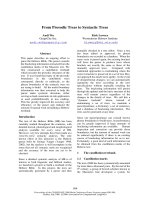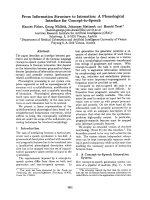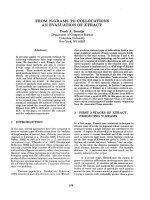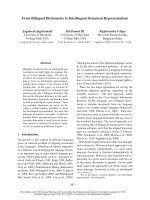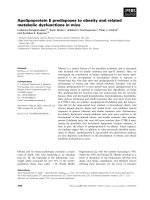Báo cáo y học: " From single cells to whole organism" pps
Bạn đang xem bản rút gọn của tài liệu. Xem và tải ngay bản đầy đủ của tài liệu tại đây (55.45 KB, 3 trang )
Genome Biology 2005, 6:365
comment
reviews
reports
deposited research
interactions
information
refereed research
Meeting report
From single cells to whole organisms
Silke Sperling
Address: Max Planck Institute for Molecular Genetics, Ihnestrasse 73, 14195 Berlin, Germany. E-mail:
Published: 3 January 2006
Genome Biology 2005, 6:365 (doi:10.1186/gb-2005-6-13-365)
The electronic version of this article is the complete one and can be
found online at />© 2005 BioMed Central Ltd
A report on the European Science Foundation Conference
‘Functional Genomics and Disease’, Oslo, Norway, 6-10
September 2005.
Functional genomics aims to provide a bridge from the static
information in the genome to the related functional proper-
ties of the cell, tissue or organism. Data on a genome-wide
level are generated using a variety of high-throughput tech-
nologies, and are analyzed using bioinformatics and system-
level integration. The program of the recent European
Science Foundation Conference on functional genomics
linked the most promising developments in functional
genomics research and technology with their applications
and future in biomedicine.
Complex genotype-phenotype relationships
Considerable effort is currently being made to reveal the
relationship between complex genotypes and phenotype, for
example, in looking at the enormous genetic variation that
exists in outbred populations such as our own and how it
manifests itself in phenotypic variation. One approach to
uncovering the molecular basis of common diseases such as
cancer and cardiovascular diseases is the correlation of
sequence variation among healthy and ill individuals to try
and understand how genetic perturbations interact to affect
clinical outcome. Analyzing genotype-phenotype relation-
ships in simpler organisms than humans, Charlie Boone
(University of Toronto, Canada) and Andrew Fraser (Well-
come Trust Sanger Institute, Cambridge, UK) reported on
global genetic-interaction projects in Saccharomyces cere-
visiae and Caenorhabditis elegans that aim to identify over-
lapping functions and compensatory pathways that
complicate the phenotype. Using an automated screen for
suppressor/enhancer mutations, Boone’s group analyzed
250,000 mutants of S. cerevisiae for synthetic genetic
sickness or lethal genotypes, which are important for
understanding how an organism tolerates random mutation.
Interestingly, the genetic-interaction map appears to be four
times as complex as the protein-protein interaction map.
Genetic interactions do not overlap with physical interac-
tions, but predict functional neighborhoods and clearly iden-
tify components of pathways whose order of action remains
to be determined.
Fraser described an RNA interference (RNAi) approach to
the construction of a genetic-interaction map, using C. elegans
fed on bacteria expressing double-stranded RNA (dsRNA).
The map was based on 200,000 experiments, in which each
gene was tested against every other one. Most interestingly,
genes involved in chromatin remodeling have the highest
number of interactions and modulate weak mutations in
other genes, such that chromatin-remodeling genes function
as phenotypic buffers. A future challenge will be to transfer
this knowledge to humans. RNAi knockdown experiments in
mammalian cells should provide further insights, as
described by René Bernards (Netherlands Cancer Institute,
Amsterdam, The Netherlands). Using this technology, he has
identified the cylindromatosis tumor suppressor gene
(CYLD) as a regulator of the anti-apoptotic transcription
factor NFB. The link with NFB suggested the possibility of
treating cylindromatosis, a tumor of skin appendages such
as sweat glands, with aspirin, because aspirin prevents
activation of NFB and thus could suppress the cell prolif-
eration. Indeed, Bernards reported the finding of disease
regression in a clinical trial of topical application of
aspirin cream.
Protein function, interaction and signaling
Two thirds of all the coding sequences from completed
genomes have been assigned to only 1,400 known domain
families, and this enables ancient evolutionary relationships
to be determined. About 200 of these domain families are
common to all kingdoms of life and new protein functions
have evolved through domain duplication and shuffling.
Christine Orengo (University College London, UK) presented a
bioinformatics perspective on how functionally related
protein families extend or decrease in size in a correlated
manner within any given species: examples are the DNA
topoisomerases and the elongation factor G (EF-G) family.
Considering that 80 genomes have been completely
sequenced, phylogenetic occurrence profiles now provide an
additional tool to extend their functional annotation. Using
data obtained by mass spectrometry and peptide arrays,
Tony Pawson (Samuel Lunenfeld Research Institute,
Toronto, Canada) pointed out that small alterations in
peptide motifs and motif shuffling can influence the activa-
tion and function of signaling proteins. For instance, single
amino-acid substitutions can alter the binding specificity of
SH2 domains. This apparent flexibility might have had an
evolutionary advantage in the sense that the binding speci-
ficity of SH2 domains might be able to change rather rapidly,
thus allowing the formation of new signaling connections as
animals became more complex.
Signaling that leads to the induction of new gene expression
enables cells to adapt to environmental changes or, in the
case of cell-cell communication, plays a major role in biolog-
ical processes such as the regulation of embryonic develop-
ment. One intriguing example of how quantitative changes
in the level of a particular signaling molecule can interfere
with morphological development was presented by Irma
Theseleff (University of Helsinki, Finland) in the context of
tooth development in mice. The development of these ecto-
dermal appendages starts from tooth placodes (thickened
plates of ectoderm) and is regulated by interactions between
epithelium and mesenchyme. The epithelial structures called
enamel knots, which regulate the morphogenesis of the
tooth crown enamel, represent signaling centers and express
commonly used developmental signaling molecules such as
bone morphogenetic proteins (BMPs), fibroblast growth
factors (FGFs), Sonic hedgehog, and Wnt proteins. Theseleff
reported that Ectodin, a secreted BMP inhibitor, is
expressed in a complementary pattern to enamel knots in
developing teeth. Ectodin-deficient mice have enlarged
enamel knots, highly altered cusp patterns on the teeth, and
extra teeth. Unlike the situation in normal teeth, excess BMP
accelerates the developmental patterning process in
Ectodin-deficient teeth. Thus, modification of the levels of
cell-cell signaling molecules affects morphology.
From bench to bedside
The brain is the most complex organ in the body and allows
us to interact with the world around us. Unlike many other
tissues, central nervous system neurons are not routinely
replaced or repaired, and when neurons are lost because of
trauma or disease there is often severe loss of function.
Because of the cellular complexity of the nervous system,
neuronal death involves many signaling pathways, the death
of one neuron affects another, and injury because of cell
death develops over time. Valina Dawson (Johns Hopkins
University, Baltimore, USA) discussed research ranging
from the inhibition of cell death to preconditioning (
using
short periods of ischemia to make the brain more resistant
to a subsequent ischemic insult) and neuroprotection.
Dawson described large-scale gene-expression experiments
that identified the gene iduna, a potential new key player in
the preconditioning process and a possible ‘druggable
target’. Iduna knockdown in mice inhibits the neuroprotec-
tive effect of preconditioning at a cellular level, whereas its
overexpression increases the protective effect. Even if it is
still a long way from bench to bedside, this is a clear example
of the ongoing translation from research to clinic.
Most disease-related molecular studies focus on the analysis
of the affected organ, tissue or cell. Much of this material is,
however, difficult to access in a routine clinical setting and is
therefore of limited value for diagnostic testing. On the other
hand, venipuncture or bloodletting was flourishing well
before Hippocrates’ time and blood is one of the easiest
tissues to access and examine in the laboratory. During its
circulation, the blood picks up proteins from all organs and
thus blood serum can be used as a window into the state of
the tissues of the body. Ruedi Aebersold (Swiss Federal
Institute of Technology (ETH), Zurich, Switzerland) pre-
sented a pioneering study showing the overlap of 3,203
N-glycosylated peptides isolated from blood serum with
various tissues such as liver, breast, lung and brain.
Although the identification of tissue- and disease-specific
protein markers is still in progress, the analysis of serum
proteome patterns opens a new window on the remote
sensing of tissue stages and changes within the body.
System-level integration
Understanding the mechanisms that sustain living systems has
always been the ultimate goal in biology, and solutions are now
coming from the relatively new discipline of systems biology.
The essence of systems biology lies not in computational power
or high-throughput analysis: it is all about dynamics, the quan-
titative analysis of biological processes over time and space.
Thus, systems biology seeks to explain biological phenomena
not on a gene-by-gene basis but through the interaction of all
the individual components in a cell or organism. As Aebersold
remarked, systems biology is the study of the syntax of biologi-
cal information, like choosing the right number of words and
putting them in the right order. Olaf Wolkenhauer (University
of Rostock, Germany) reviewed recent approaches to mathe-
matical modeling and the simulation of fundamental dynamic
processes such as gene expression and cell signaling, and
pointed out that the intracellular location of components can
induce a time delay in their actions that has been ignored in
modeling so far. For example, the need for transport into the
nucleus produces a delay between the activation of the extracel-
lular signal-related kinase by phosphorylation in the cytoplasm
and its activity in phosphorylating transcription factors within
the nucleus.
365.2 Genome Biology 2005, Volume 6, Issue 13, Article 365 Sperling />Genome Biology 2005, 6:365
To enable sophisticated biological and computational
approaches, new molecular tools for high-throughput analysis
and even single-molecule detection and quantitation are
currently being developed. Ulf Landegren (Uppsala Univer-
sity, Sweden) described a set of such tools, namely the circu-
larizing nucleic acid probes known as ‘padlock’ probes,
proximity ligation and rolling-circle amplification assays,
which can be applied to the quantification of very large sets
of molecules in solution or in situ on a single-cell level. In
these applications, the probe molecules used to detect DNA,
RNA or proteins are in the form of short DNAs that circular-
ize on binding their target and are then amplified by rolling-
circle replication.
The meeting covered a wide range of topics, from single cells
to whole organisms, and clearly demonstrated that functional
genomics is a growing interdisciplinary field. The future will
undoubtedly show an increasing impact of functional
genomics on disease-related research.
comment
reviews
reports
deposited research
interactions
information
refereed research
Genome Biology 2005, Volume 6, Issue 13, Article 365 Sperling 365.3
Genome Biology 2005, 6:365

